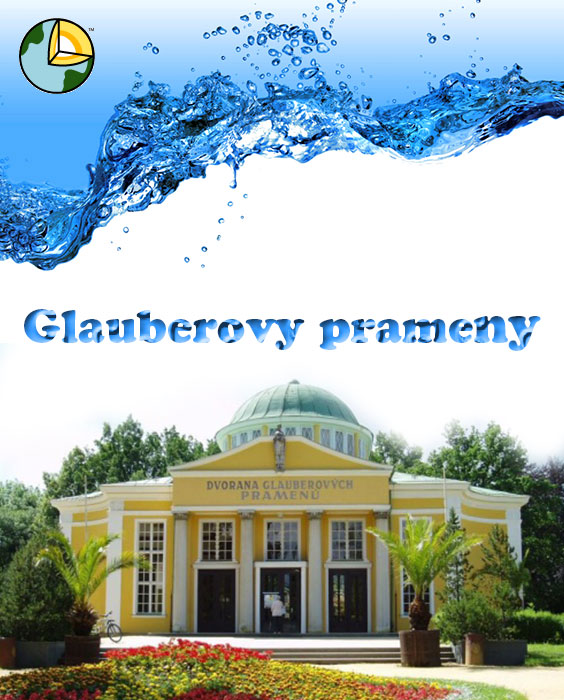
Glauberovy prameny jsou celkem ctyri a nesou jmeno znameho nemeckeho alchymisty 17. stoleti Johanna Rudolfa Glaubera, ktery pracoval na vyrobe univerzalniho rozpoustedla, pricemz jako vedlejsi produkt sveho snazeni ziskal roku 1625 siran sodny - Glauberovu sul (Na2SO4+H2O).
Tato sloucenina s vysoce projimavymi ucinky tvori vyznamnou soucast vsech ctyr pramenu , ktere se navzajem lisi mineralizaci a obsahem CO2.
In Franzensbad Spa you can find four Glauber springs. They were discovered after the WW1 and named after a famous German alchemist of 17th century Johann Rudolf Glauber. In 1625 he was in a process of making a universal solvent and as a byproduct he discovered sodium sulphate - Glauber's salt (Na2SO4 + H2O). This compound, which has high laxative effect, is a significant part of the springs. The springs itself can be distinguished by mineralization and a content of CO2.
Glauber I. vyvera v empirovem pavilonku u Labutiho jezirka,ma prijemnou chut , mirne projimave ucinky a ordinuje se pri strevnich a zaludecnich katarech,pramen pochazi z roku 1919 a vyvera z hloubky 33,3m.
Glauber I. rises in the pavilion (built in the Empire style) near the Swan Lake. It has a pleasant taste, and because of its laxative effect it is prescribed for the patients with stomach and intestinal catarrh. The spring dates from 1919 and it rises from the depth of 33,3 meters.
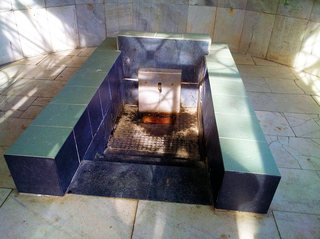 
Glauber II. vyvera v drevenem pavilonku v Dvorakovych sadech, ma podobne ,ale slabsi ucinky ,nez Glauber I.Pramen pochazi z roku 1925 a vyvera z hloubky 25m.
Glauber II rises in the wooden pavilion in the Dvorak garden and has similar, but weaker effects than the Glauber spring I. It dates from 1925 and rises from the depth of 25 meters.
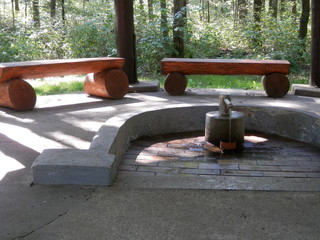 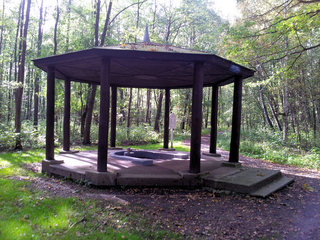
Glauber III. vyvera spolu s Glauber IV. ve dvorane Glauberovych pramenu-honosnem pavilonu z roku 1930.Ma vyrazny projimavy ucinek a ordinuje se pri zacpe,ktera je castym doprovodnym jevem gynekologickych i jinych zde lecenych chorob.Pramen pochazi z roku 1921.
Glauber III. rises together with Glauber IV in the Glauber Spring Hall. This glamorous pavilion has been standing in Franzensbad Spa since 1930. Spring itself dates from 1921 and has distinctive laxative effect and is prescribed for constipation that is often secondary symptom to gynecological or other condition.
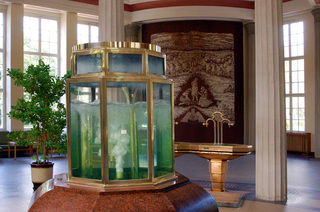 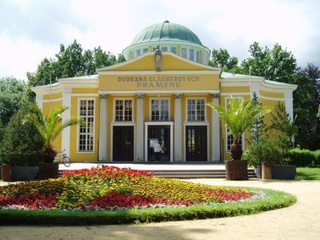
Glauber IV. ma mohutny projimavy ucinek a nejlepe se snasi mirne zahraty.Je to pramen s nejvetsim obsahem Glauberovy soli na svete,s nejvyssi celkovou mineralizaci ve Frantiskovych laznich a potazmo i v cele oblasti zapadoceskych kyselek.U nas se vyskytuji silneji mineralizovane vody pouze na Ostravsku.Glauberovy prameny byly objeveny vrty po prvni svetove valce.Pramen pochazi z roku 1919 a vyvera z hloubky 92,6m.
Glauber IV. has massive laxative effect and it is better tolerated when heated a little. This spring has the highest content of Glauber salt in the world, the highest mineralization in Franzensbad Spa and by extension in the whole region of west Bohemian. We can find more mineralized water only in Ostrava region. Spring dates from 1919 and rises from the depth of 92,6 meters.
 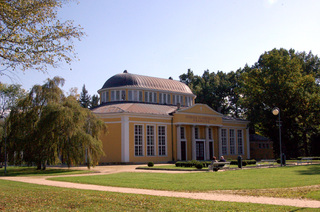
Vznik mineralnich vod
Mineralni vody jsou prirozene prirodni smesi a roztoky ruzne koncentrace,jejichz vznik a slozeni podminila rada cinitelu.Mezi hlavni patri charakter a puvod vody, vlastnosti hornin, syceni vody plynem, biochemicke procesy a geologicky vyvoj v dane oblasti.
Jednotlivi cinitele ovlivnujici vznik, kvalitu a vlastnosti mineralni vody pusobi casto soucasne a dlouhodobe.Nejdulezitejsi pro vznik mineralni vody je interakce mezi podzemni vodou a horninou, coz zahrnuje celou skalu chemickych pochodu (rozpousteni, hydratace, hydrolyza, oxidace, redukce, rozpousteni kyselinami).Vyznamnou roli sehrava take prinos plynu (CO2, H2S) a u vod starsiho a hlubsiho puvodu rovnez metamorfoza a zvysena teplota vedouci k vymene iontu.Mineralni vody mohou vznikat behem jednoho relativne kratkeho procesu o trvani radove dny az tydny (napriklad postupne zvysovani teploty a mineralizace, metamorfoza, obohacovani CO2, vystup k povrchu).
Obecne lze mineralni vody rozdelit na hlavni dve skupiny, a to vody pevninskeho puvodu (vznikly z vod puvodem ze zemskeho povrchu, ktere vsakly do podzemi) a vody morskeho puvodu (vznikly z vod mori nebo slanych jezer, uzavrenych pri sedimentaci ve vrstvach hornin).Mezi obema zakladnimi typy existuji ruzne prechody diky miseni v podzemi (jeden typ muze obsahovat slozku druheho typu a naopak).
The creation of mineral water
Mineral water is natural solution with different concentration of minerals. Their origin and composition are influenced by a number of factors. The main factors include the nature and origin of the water, rock properties, gas saturation, biochemical processes and geological development in the area.
The different factors that influence the creation, quality and properties of the mineral water have often combined long-term impact.
The most important thing for the creation of mineral water is the interaction between the ground water and a rock. This interaction includes a wide range of chemical processes such as dissolution, hydration, hydrolysis, oxidation, reduction and acid dissolution. The gas supply (CO2, H2S) also plays an important role and with water that has older and deeper origin the metamorphosis and higher temperature that leads to the ion exchange plays significant role too.
Mineral water can arise during a relatively short process that takes days or weeks (e.g. progressive increase of temperature and mineralization, metamorphosis, CO2 enrichment or rise to the surface).
In general, mineral water can be categorized into two groups. First one is continental water that soaks into ground, second is salty water from a closed space (sea, lake) that is trapped into the layer of rocks during sedimentation. The two groups can overlaps when the salt water is mixed with the continental in the underground.
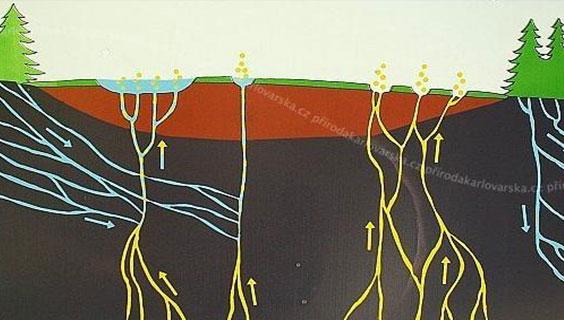
Mineralni vody pevninskeho puvodu maji variabilni mineralizaci i obsah plynu.Nejbeznejsimi rozpoustenymi chemickymi slozkami byvaji z aniontu hydrogenuhlicitany (HCO3), chloridy (CI) a sirany (SO4),z kationu sodik (NA), draslik (K), vapnik(CA) a horcik (MG).Ke zvlast cenenym latkam , ktere jsou pritomny ovsen jen v malych koncentracich,patri jodidy (J), fluoridy (F) a zelezo (FE) nebo radioaktivni slozky.Z plynu byva nejbeznejsi CO2 a H2S.
Continental mineral water has variable degree of mineralization and gas. The most common chemical compounds dissolved in the water are bicarbonate anions (HCO3-), chlorides (Cl-) and sulphates (SO42-) and from cation group Sodium (Na), Potassium (K), Calcium (Ca) and Magnesium (Mg). There are also some elements that are present in small concentrations but they are still highly valuable such as Iodine (I), Fluor (F) and Iron (Fe) or some radioactive components. The two most common gases are carbon dioxide (CO2) and hydrogen sulfate (H2S).
Mineralni vody morskeho puvodu byvaji silne az velmi silne mineralizovane, prevladajici slozkou je CI a NA, vykazuji zvyseny obsah jodidu, amoniaku, kyseliny borite, muze byt pritomny metan a ropne latky.
Nutno take zminit, ze kazda mineralni voda obsahuje bakterie.Jejich slozeni se pro vysokou variabilitu nesleduje (krome hygienycky zavadnych typu).Prave pritomnost bakterii (a take stopovych prvku a organickych latek) odlisuje prirodni mineralni vody od umelych mineralnich vod, jez se pokusne vyrabely v 19.stoleti rozpustenim prislusneho mnozstvi anorganickych latek do obycejne proste vody.Snaha skoncila bezuspesne a takto vyrobene vody si vetsinou nikdy neziskaly oblibu.
Mineralni vody vykazuji v prubehu casu zmeny.Obecne plati, ze vody hlubsiho puvodu jsou stabilnejsi nez vody z melkeho puvodu.Na nektere proplynene mineralni vody maji vliv zmeny barometrickeho tlaku , coz se projevuje kolisanim vydatnosti zdroje.Vliv atmosferickych srazek se projevuje prakticky u vsech zridel, mnohdy se spozdenim nekolika mesicu.Teploty melkych mineralnich vod souvideji s teplotou ovzdusi.Zmeny vydatnosti zdroje se obvykle projevuji zmenami chemickeho slozeni.Trvale snizovani mineralizace svedci o vycerpavani chemickych latek nebo o vycerpavani staticke zasoby mineralnich vod.
Salty mineral water is usually strongly mineralized, the main components are Na and Cl and there is also increased content of Iodine, Ammonia and Boric acid. Methane and oil products can be also present.
It should be mentioned that every mineral water contains bacteria. Their composition is not being watched closely because of their great variability (except the types that are harmful to the health). It is because of the presence of bacteria and trace elements and organic compounds that we can distinguish the natural mineral water from the artificial one.
Mineral water also shows some changes over time. In general, the deeper the water is the more stable it becomes. Gas-charged water can be affected by changes in barometric pressure which results in fluctuation of the spring abundance.
Atmospheric precipitation also influences almost every spring.
Temperature of the shallow springs correlates with the temperature of the air. Changes in the spring abundance are usually manifested by the changes in chemical composition of water.
The continuous reduction of mineralization indicates depletion of chemical compounds as well as exhaustion of the mineral water static reserves.
Otazky pro splneni logu Found it :
1) Seradte prameny podle nejnizsiho obsahu CO2.
2) Popiste vlastnimi slovy chut nektereho z Glauberovych pramenu.Osvezujici chut se nepocita.
3) Na kolik zakladnich typu se deli mineralni vody?Odpoved naleznete v listingu.
4) Uvnitr dvorany se nachazi model dvorany.Zjistete v kolika metrech zacina VRSTVA z ktere vyvera pramen Glauber IV..Nepiste mi ze je to 92,6m.
5) Jako dobrovolny ukol muzete prilozit fotografii vas a GPS u nektereho z Glauberovych pramenu.
Odpovedi odesilejte pres profil.Pokud nebude neco v poradku tak se ozvu.
Logy bez odeslanych odpovedi budou smazany.
Dvorana Glauberovych pramenu je otevrena zdarma, Po - Ne : 07:00-18:00 celorocne.
If you want to log this cache you have to answer these questions:
1) Sort the springs by content of CO2, start with the lowest content.
2) Try to describe the taste of Glauber spring. Try something more sophisticated than “fresh”. ;)
3) How many types of mineral water there are? (see listing)
4) Inside of the Glauber Spring Hall there is a model of the Glauber springs. I would like to know how deep is (in meters) the layer from which the Glauber spring IV rises (92,6 meters is incorrect answer).
5)You can attach photos with you and some of the Glauber springs. (optional)
Please, send me the answers via profile. If something is incorrect I will contact you.
Logs without the send answers will be deleted.
The Glauber Spring Hall is opened whole year, Monday – Sunday, from 7 am to 6 pm, with free entrance.
Zdroje:
Martin Janoska , Mineralni prameny v Cechach na Morave a Slezsku (ISBN 978-80-200-1615-7)
www.estudanky.cz
www.turistika.cz
www.prirodakarlovarska.cz
 |